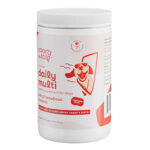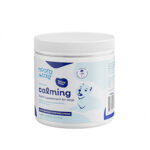Outline for Treating Dogs with Bloody Stool

Understanding Bloody Stool
Bloody stool, also known as hematochezia, is a concerning symptom that can indicate underlying health issues in dogs. The presence of blood in the stool can be caused by various factors, ranging from minor irritations to more serious medical conditions.
Causes of Bloody Stool in Dogs
- Dietary indiscretion: Consuming foreign objects or spoiled food can cause irritation and bleeding in the digestive tract.
- Inflammatory bowel disease (IBD): Chronic inflammation of the digestive tract can lead to bleeding and other gastrointestinal symptoms.
- Parasites: Internal parasites, such as hookworms and roundworms, can cause intestinal damage and bleeding.
- Trauma: Injuries to the digestive tract, such as from a swallowed object or blunt force trauma, can cause bleeding.
- Coagulation disorders: Abnormalities in the blood clotting process can result in bleeding in the stool.
- Cancer: Certain types of cancer, such as lymphoma, can cause bleeding in the digestive tract.
Symptoms Associated with Bloody Stool
- Diarrhea or loose stools
- Straining or vomiting
- Abdominal pain or discomfort
- Lethargy or weakness
- Weight loss
- Anemia (in severe cases)
Diagnosis
Diagnosing the underlying cause of bloody stool requires a thorough clinical examination and diagnostic tests. Your veterinarian will perform a physical exam, obtain a history of the dog’s symptoms, and order tests to evaluate organ function, check for parasites, and exclude other potential causes.
Treatment
The treatment for bloody stool depends on the underlying cause.
- Dietary indiscretion: Withhold food for 12-24 hours and gradually reintroduce a bland diet.
- Inflammatory bowel disease: Anti-inflammatory medications, dietary changes, and probiotics may be recommended.
- Parasites: Anthelmintic medications will be prescribed to kill the parasites.
- Trauma: Surgery or other treatments may be necessary to address the underlying injury.
- Coagulation disorders: Blood transfusions or medications to improve clotting may be required.
- Cancer: Treatment will vary depending on the type and stage of cancer.
Home Care and Prevention
- Feed your dog a high-quality diet and avoid giving them table scraps or unhealthy snacks.
- Keep your dog up-to-date on vaccinations and deworming.
- Prevent your dog from eating foreign objects or spoiled food.
- If you notice any signs of digestive upset, contact your veterinarian promptly.
When to Seek Veterinary Attention
It is crucial to seek veterinary attention immediately if your dog exhibits any of the following symptoms:
- Bright red or black, tarry stool
- Severe diarrhea or vomiting
- Abdominal pain or tenderness
- Lethargy or weakness
- Weight loss
Conclusion
Bloody stool in dogs can be a sign of various health conditions. It is essential to seek professional veterinary care to diagnose and treat the underlying cause promptly. With appropriate and timely treatment, most dogs with bloody stool can make a full recovery.
Determine the Cause:

Experiencing bloody stool in your beloved dog can be a distressing and alarming situation. The sight of red or maroon-colored stools, known as hematochezia, signifies the presence of blood in the digestive tract. It’s crucial to address this issue promptly to prevent potential health complications.
Determining the Cause
When encountering bloody stool in your dog, the first step is to determine the underlying cause. Observation of your dog’s symptoms and a consultation with a veterinarian are essential for accurate diagnosis. Some common causes of bloody stool in dogs include:
-
Parasites: Intestinal parasites such as whipworms, hookworms, and roundworms can cause inflammation and bleeding in the digestive tract, leading to bloody stool.
-
Infection: Bacterial or viral infections, such as salmonella or parvovirus, can cause severe diarrhea and vomiting, which may result in bloody stools.
-
Diet: Changes in diet, particularly introducing new foods or treats, can upset the digestive system, leading to bloody stool in some dogs.
-
Other Conditions: Colitis (inflammation of the colon), inflammatory bowel disease (IBD), and gastrointestinal bleeding can also cause bloody stool in dogs.
Immediate Actions
-
Rest and Hydration: Keep your dog rested and ensure they have access to fresh water to prevent dehydration.
-
Bland Diet: Offer a bland diet, such as boiled chicken and rice, to reduce stomach upset and irritation.
-
Veterinary Consultation: Schedule an appointment with your veterinarian as soon as possible to determine the exact cause and initiate appropriate treatment.
Treatment Options
Depending on the underlying cause, your veterinarian may recommend specific treatments for your dog:
-
Antiparasitics: If parasites are identified as the cause, your veterinarian will prescribe appropriate deworming medication.
-
Antibiotics: In cases of bacterial infection, antibiotics will be administered to combat the infection.
-
Diet Adjustment: Changes to your dog’s diet may be recommended to address any dietary sensitivities or intolerances.
-
Medication: Medications, such as anti-inflammatory drugs or probiotics, may be prescribed to reduce inflammation and support gut health.
-
Surgery: In severe cases, such as gastrointestinal bleeding, surgery may be necessary to address the underlying issue.
Prevention
Preventing bloody stool in dogs involves addressing the potential causes:
-
Regular Deworming: Protect your dog from intestinal parasites by following a regular deworming schedule recommended by your veterinarian.
-
Vaccination: Vaccinations can help prevent infections that can lead to bloody stool.
-
Safe Diet: Feed your dog a balanced diet and avoid sudden changes to prevent digestive upset.
-
Regular Checkups: Schedule regular checkups with your veterinarian to detect and address any potential health issues before they become more significant.
Conclusion
Bloody stool in dogs can be a symptom of various underlying health conditions. By observing your dog’s symptoms, consulting with a veterinarian, and addressing the root cause, you can effectively manage bloody stool and ensure the well-being of your beloved companion. Remember that early intervention is crucial for successful treatment and recovery.
Rest the Digestive Tract:

When you notice bloody stool in your dog, it’s a concerning sign that requires prompt attention. Bloody stool, also known as hematochezia, can indicate an underlying health issue that needs to be addressed. In this article, we will delve into the causes of bloody stool in dogs and provide practical recommendations on what to give your furry companion to help alleviate the symptoms.
Causes of Bloody Stool in Dogs
The presence of blood in the stool can have several underlying causes, including:
- Gastrointestinal disorders: Inflammatory bowel disease (IBD), colitis, and other digestive issues can cause inflammation and bleeding in the digestive tract.
- Intestinal parasites: Hookworms, whipworms, and other parasites can damage the intestinal lining, leading to bleeding and bloody stool.
- Dietary indiscretion: Ingestion of foreign objects, spoiled food, or toxic substances can irritate the digestive tract and cause bleeding.
- Infections: Bacterial or viral infections can disrupt the normal function of the digestive system, resulting in inflammation and bleeding.
- Trauma: Injuries to the digestive tract, such as bites or accidents, can cause bleeding.
- Cancer: In rare cases, bloody stool can be a symptom of underlying cancer in the digestive system.
What to Give a Dog with Bloody Stool
The treatment for bloody stool depends on the underlying cause. However, there are some general measures you can take to help your dog while you seek veterinary attention:
1. Rest the Digestive Tract
Withhold food for 12-24 hours to allow the digestive tract to rest and reduce inflammation. Water should still be provided in small amounts to prevent dehydration.
2. Offer a Bland Diet
After the fasting period, gradually introduce a bland diet that is easy to digest and low in fiber. This can include boiled chicken or fish with white rice, sweet potatoes, or pumpkin.
3. Adjust the Feeding Schedule
Feed your dog small, frequent meals throughout the day rather than one or two large meals. This helps reduce the amount of food passing through the digestive tract at once.
4. Increase Water Intake
Encourage your dog to drink plenty of water to stay hydrated and support the digestive system. You can offer ice cubes or flavored water to make it more appealing.
5. Administer Probiotics
Probiotics are beneficial bacteria that support the health of the digestive tract. They can help restore the balance of gut flora and reduce inflammation.
6. Use Anti-diarrheal Medication
Your veterinarian may recommend anti-diarrheal medication to help control the bleeding and diarrhea. These medications should only be used under veterinary supervision.
7. Rule Out Parasites
Have your veterinarian perform a fecal exam to rule out intestinal parasites. If parasites are present, appropriate antiparasitic medication will be prescribed.
Warning Signs
If bloody stool is accompanied by any of the following symptoms, seek veterinary attention immediately:
- Vomiting
- Diarrhea
- Lethargy
- Abdominal pain
- Weight loss
- Fever
- Black, tarry stool
Conclusion
Bloody stool in dogs is a concerning symptom that should not be ignored. By understanding the potential causes and following the recommended steps, you can help alleviate the symptoms and support your dog’s digestive health. Remember, it is essential to consult with your veterinarian for an accurate diagnosis and appropriate treatment plan. By working together, you can ensure that your furry companion receives the care they need to recover from bloody stool and maintain a healthy digestive system.
Offer Bland Diet:

Bloody stool, medically known as hematochezia, is a common canine concern that can be caused by various underlying medical conditions. When a dog’s stool contains fresh, bright red blood, it often signifies a problem within the lower digestive tract, such as the colon, rectum, or anus.
If your dog exhibits bloody stool, it is crucial to seek veterinary attention promptly to determine the cause and administer appropriate treatment. The veterinarian will conduct a thorough physical examination, obtain a medical history, and may order diagnostic tests such as fecal analysis, blood work, and imaging studies to identify the underlying issue.
While waiting for veterinary consultation, there are some measures you can take to help alleviate your dog’s discomfort and support their recovery. One important step is to offer your dog a bland diet.
What is a Bland Diet?
A bland diet is designed to be gentle on your dog’s digestive system. It typically consists of easily digestible ingredients that are low in fiber and fat. The goal of a bland diet is to reduce inflammation and irritation within the digestive tract, promoting healing and recovery.
Introducing a Bland Diet for Bloody Stool
Once your dog has fasted for 12-24 hours, gradually introduce a bland diet. Start by offering small, frequent meals throughout the day. Monitor your dog’s response and adjust the feeding schedule as needed.
Components of a Bland Diet
The following ingredients are commonly used in bland diets for dogs with bloody stool:
- Boiled white rice: White rice is a low-fiber, easily digestible carbohydrate that provides essential energy.
- Lean protein: Lean protein sources such as boiled chicken or fish provide amino acids necessary for tissue repair and recovery.
- Cottage cheese: Cottage cheese is a soft, low-fat protein source that is easy on the stomach.
- Yogurt: Plain, unsweetened yogurt contains probiotics, beneficial bacteria that support digestive health.
- Pumpkin puree: Canned pumpkin puree is high in fiber and can help regulate bowel movements.
Caution:
- Avoid spicy foods, fatty meats, dairy products, and sugary treats, as these may irritate your dog’s digestive system and worsen their condition.
- Do not give your dog over-the-counter medications such as aspirin or ibuprofen, as these can have harmful side effects in dogs.
- If your dog’s bloody stool persists or worsens, seek veterinary attention immediately.
Additional Tips
In addition to a bland diet, here are some other tips to help your dog recover from bloody stool:
- Keep your dog hydrated: Offer your dog plenty of fresh water to prevent dehydration.
- Monitor your dog’s activity level: Restrict your dog’s exercise until they feel better.
- Provide a comfortable and stress-free environment: Create a quiet and relaxing space for your dog to rest and recover.
- Follow your veterinarian’s instructions: Adhere to the recommended treatment plan and follow-up appointments to ensure your dog’s recovery and prevent complications.
Remember that bloody stool can be a sign of a serious underlying medical condition. If your dog exhibits this symptom, it is crucial to seek veterinary attention promptly. By providing your dog with a bland diet and following these guidelines, you can support their recovery and improve their overall well-being.
Use Anti-Inflammatory Medications:
Introduction:
Bloody stool, medically known as hematochezia, is a distressing symptom that can indicate underlying health issues in dogs. The presence of blood in feces ranges from subtle streaks to significant amounts, and the color can vary from bright red to dark maroon. Understanding the potential causes and taking prompt action is crucial for your dog’s health and well-being.
Potential Causes of Bloody Stool:
The presence of blood in a dog’s stool can be triggered by various factors, including:
- Inflammatory Bowel Disease (IBD): An inflammation of the digestive tract, IBD can cause bloody diarrhea, vomiting, weight loss, and abdominal pain.
- Dietary Indiscretion: Consuming unusual or inappropriate food items can irritate the digestive system and lead to bloody stool.
- Parasites: Internal parasites, such as hookworms and roundworms, can cause inflammation and bleeding in the intestines.
- Foreign Body Ingestion: Swallowing sharp objects, toys, or other non-edible materials can puncture the digestive tract and cause bleeding.
- Colitis: Inflammation of the colon can result in bloody diarrhea, straining, and tenesmus (difficulty defecating).
- Stress or Anxiety: Psychological factors can trigger digestive upset and lead to bloody stool in some dogs.
Clinical Signs:
Bloody stool is often accompanied by other clinical signs, depending on the underlying cause, such as:
- Diarrhea or constipation
- Vomiting
- Abdominal pain or discomfort
- Loss of appetite
- Lethargy or weakness
- Straining or difficulty defecating
Emergency Considerations:
If your dog exhibits sudden onset of bloody stool, especially if accompanied by vomiting or severe abdominal pain, seek immediate veterinary attention. This could indicate a life-threatening condition, such as internal bleeding or a perforated intestine.
Home Remedies for Mild Cases:
For mild cases of bloody stool, there are a few home remedies that can provide relief:
- Withhold Food for 12-24 Hours: Allow your dog’s digestive system to rest and empty out any potential irritants.
- Offer Small Amounts of Water: Keep your dog hydrated but avoid overfeeding, as this can worsen diarrhea.
- Boiled Chicken and Rice: A bland diet of boiled chicken and white rice can help soothe an upset stomach.
- Plain Pumpkin Puree: The fiber in pumpkin can help firm loose stools.
When to Seek Veterinary Care:
If your dog’s bloody stool persists, worsens, or occurs alongside other clinical signs, it’s crucial to seek veterinary care. Your veterinarian will perform a thorough physical examination, collect a fecal sample for analysis, and potentially recommend further diagnostic tests (e.g., bloodwork, X-rays).
Veterinary Treatment Options:
Depending on the underlying cause, your veterinarian may recommend a range of treatments, including:
- Antibiotics: To combat bacterial infections
- Anti-inflammatory Medications: To reduce inflammation in the digestive tract
- Antiparasitic Medications: To eliminate internal parasites
- Dietary Modification: To address food sensitivities or intolerances
- Surgery: In severe cases, surgery may be necessary to remove a foreign body or treat a perforated intestine
Prevention:
While not all causes of bloody stool can be prevented, there are proactive measures you can take to minimize the risk:
- Feed a High-Quality Diet: Provide your dog with a well-balanced diet formulated for their age, size, and activity level.
- Avoid Dietary Changes: Transition your dog to new foods gradually to prevent digestive upset.
- Deworm Regularly: Schedule regular deworming treatments to prevent parasitic infections.
- Keep Your Dog Out of Trouble: Supervise your dog outside and secure potential hazards to avoid foreign body ingestion.
- Manage Stress: Provide plenty of exercise, mental stimulation, and affection to reduce anxiety in your dog.
Conclusion:
Bloody stool in dogs can be a worrying symptom, but it’s important to remain calm and seek veterinary attention if necessary. By understanding the potential causes, observing your dog’s behavior, and following the recommended treatment plan, you can help your furry friend heal and prevent future episodes. Remember, your dog’s health is a priority, and it’s always better to err on the side of caution when it comes to bloody stool.
Treat Parasites:
Bloody stool, also known as hematochezia, is a common problem in dogs that can be caused by a variety of underlying medical conditions. While it can be alarming to see blood in your dog’s stool, it is important to remain calm and seek veterinary attention as soon as possible.
Causes of Bloody Stool in Dogs
The most common causes of bloody stool in dogs include:
- Parasites: Intestinal parasites, such as hookworms, roundworms, and whipworms, can damage the lining of the intestines, causing inflammation and bleeding.
- Inflammatory bowel disease (IBD): This chronic condition causes inflammation in the gastrointestinal tract, which can lead to bleeding, diarrhea, and other digestive problems.
- Colitis: Inflammation of the colon can cause bloody diarrhea. This can be caused by a variety of factors, including stress, dietary changes, and infections.
- Intestinal tumors: Tumors in the intestines can cause bleeding, pain, and other digestive symptoms.
- Trauma: Physical trauma to the intestines, such as from a foreign body or an injury, can cause bleeding.
- Dietary indiscretion: Eating something unusual, such as spoiled food or garbage, can irritate the stomach and intestines, leading to bloody stool.
- Infections: Bacterial or viral infections, such as parvovirus or salmonella, can cause severe diarrhea and bloody stool.
Treatment for Bloody Stool in Dogs
The treatment for bloody stool in dogs will depend on the underlying cause. Your veterinarian will perform a physical examination, take a blood sample, and examine a stool sample to determine the cause of the bleeding.
If parasites are confirmed as the cause, your veterinarian will administer deworming medications as directed. These medications will kill the parasites and help to resolve the bloody stool.
Other treatments for bloody stool in dogs may include:
- Antibiotics: If an infection is suspected, your veterinarian may prescribe antibiotics to treat it.
- Anti-inflammatory medications: These medications can help to reduce inflammation in the intestines and stop bleeding.
- Dietary changes: Your veterinarian may recommend a bland diet for your dog to help settle its stomach and reduce digestive upset.
- Surgery: In severe cases, surgery may be necessary to remove a tumor or repair damaged intestines.
Home Care for Dogs with Bloody Stool
In addition to veterinary treatment, there are some things you can do at home to help your dog with bloody stool:
- Restrict your dog’s activity: Keep your dog calm and quiet to avoid further irritation to the intestines.
- Feed your dog a bland diet: This will help to settle its stomach and reduce digestive upset.
- Offer plenty of fluids: This will help to prevent dehydration and keep your dog’s stools soft.
- Monitor your dog’s stools: Note the frequency, consistency, and color of your dog’s stools so that you can report any changes to your veterinarian.
Prevention of Bloody Stool in Dogs
There are a few things you can do to help prevent bloody stool in your dog:
- Regularly deworm your dog: This will help to prevent intestinal parasites.
- Feed your dog a healthy diet: A well-rounded diet will help to keep your dog’s digestive system healthy.
- Avoid feeding your dog spoiled food or garbage: This can irritate the stomach and intestines.
- Keep your dog’s vaccinations up to date: This will help to protect your dog from infections that can cause bloody stool.
- Take your dog to the veterinarian for regular checkups: This will help to detect any underlying medical conditions that could cause bloody stool.
Bloody stool in dogs can be a serious problem, but it can be successfully treated with the proper care. If your dog is experiencing bloody stool, it is important to seek veterinary attention as soon as possible.
Treat Bacterial Infection:
Bloody stools in dogs can be a distressing and alarming sight for pet owners. While the presence of blood in a dog’s feces can indicate various underlying health issues, bacterial infections are a common culprit. In such cases, understanding the appropriate treatment options is crucial to ensuring a dog’s swift recovery.
Identifying Bacterial Infections
Bacterial infections in dogs can be caused by a wide range of microorganisms, such as Escherichia coli (E. coli), Salmonella, and Clostridium perfringens. These bacteria can enter a dog’s digestive system through contaminated food, water, or contact with infected animals or environments.
Symptoms associated with bacterial infections include:
- Bloody stool
- Diarrhea
- Vomiting
- Abdominal pain
- Fever
- Lethargy
Treatment Options: Antibiotics
When veterinary examination confirms a bacterial infection as the cause of bloody stools, antibiotics will typically be prescribed to combat the infection. Antibiotics work by targeting and killing the bacteria responsible for the infection.
Commonly prescribed antibiotics for bacterial infections in dogs include:
- Amoxicillin-clavulanate
- Cephalexin
- Metronidazole
- Enrofloxacin
Choosing the Right Antibiotic
The specific antibiotic prescribed by a veterinarian will depend on the type of bacteria identified in the dog’s stool sample. It is important to administer antibiotics exactly as directed by the veterinarian, completing the entire course of treatment to prevent the recurrence of the infection.
Additional Support Measures
In addition to antibiotics, other measures may be recommended by a veterinarian to support a dog’s recovery from a bacterial infection:
- Bland Diet: Feeding a bland diet, such as boiled chicken and rice, can help soothe the digestive tract and reduce the risk of further irritation.
- Probiotics: Probiotics are beneficial bacteria that can help restore the balance of the gut microbiome and support digestive health.
- Rest: Providing a dog with a quiet and comfortable place to rest can help reduce stress and promote healing.
- Hydration: It is essential to ensure that a dog remains well-hydrated during and after an infection, as diarrhea and vomiting can lead to dehydration.
Prevention
Preventing bacterial infections in dogs involves following good hygiene practices and minimizing exposure to potential sources of contamination. Key preventive measures include:
- Providing clean food and water bowls
- Regularly disinfecting common areas where dogs gather
- Vaccinating dogs against common bacterial infections
- Avoiding contact with infected animals or areas
Conclusion
Bloody stool in dogs can be a sign of a bacterial infection. Veterinary diagnosis is essential to determine the underlying cause and provide appropriate treatment. Antibiotics are typically prescribed to combat bacterial infections, and additional support measures, such as a bland diet, probiotics, and rest, may be recommended. By adhering to the veterinarian’s instructions and taking preventive measures, pet owners can help their dogs recover from bacterial infections and maintain optimal digestive health.
Introduce Probiotics:
Bloody stool, also known as hematochezia, is an alarming sight that can indicate underlying health issues in your dog. While it’s important to seek veterinary attention promptly, there are some home remedies that can provide relief and support while you wait for professional care.
Potential Causes of Bloody Stool
Determining the underlying cause of bloody stool is crucial for effective treatment. Some common causes include:
- Infections: Bacterial, viral, and parasitic infections can irritate the intestines, leading to inflammation and bleeding.
- Inflammatory bowel disease (IBD): This chronic condition causes inflammation and damage to the digestive tract, which can manifest as bloody stool.
- Parasites: Worms, such as hookworms and whipworms, can attach to the intestinal lining and cause bleeding.
- Trauma: Ingesting sharp objects or experiencing injury can lead to trauma and internal bleeding in the intestines.
- Coagulopathies: Disorders that affect blood clotting can result in excessive bleeding, which can manifest in the stool.
Home Remedies for Bloody Stool
While veterinary care is essential, the following home remedies can provide temporary relief and support for your dog:
1. Withhold Food for 12-24 Hours: Restricting food intake can give the digestive system time to calm down and reduce inflammation. However, ensure your dog has access to plenty of water to stay hydrated.
2. Introduce Probiotics: Probiotics are beneficial bacteria that help restore the balance of gut flora and support digestive health. You can purchase probiotic supplements or give your dog plain yogurt with live cultures.
3. Offer Bland Diet: Once your dog has fasted for a few hours, gradually introduce a bland diet to help soothe the digestive tract. Cooked rice, boiled chicken, or sweet potatoes are good options. Avoid feeding your dog table scraps or fatty foods.
4. Keep Your Dog Hydrated: Dehydration can worsen bloody stool. Encourage your dog to drink plenty of water or administer fluids through an oral syringe if necessary.
5. Use a Warm Compress: Applying a warm compress to your dog’s abdomen can help relieve cramps and discomfort associated with bloody stool.
6. Give Your Dog Rest: Rest is essential for your dog’s recovery. Provide a quiet and comfortable place for them to relax and avoid strenuous activities.
Important Considerations
- Seek Veterinary Attention Promptly: While home remedies can provide temporary relief, it’s crucial to seek veterinary care as soon as possible to determine the underlying cause of the bloody stool and provide appropriate treatment.
- Avoid Over-the-Counter Medications: Do not give your dog over-the-counter anti-diarrheal medications without consulting a veterinarian. These medications can suppress symptoms but may mask serious underlying conditions.
- Monitor Your Dog Closely: Observe your dog’s behavior, appetite, and stool consistency regularly. If the bloody stool persists or worsens, contact your veterinarian immediately.
Conclusion
Bloody stool in dogs can be a concerning symptom, but home remedies can provide temporary relief while you await veterinary attention. Remember to seek professional care promptly to address the underlying cause and ensure your dog’s well-being.
Avoid Certain Foods:
When your beloved canine companion experiences the unsettling symptom of bloody stool, it can be alarming and concerning. While the sight of blood in your dog’s stool can be distressing, it is crucial to remain calm and seek professional veterinary care promptly. Determining the underlying cause of the bloody stool is paramount to providing appropriate treatment and ensuring your dog’s well-being.
In the meantime, supporting your dog’s digestive system with a tailored diet can alleviate discomfort and promote healing. Here’s a comprehensive guide on what to feed a dog with bloody stool:
Determining the Cause of Bloody Stool
Before adjusting your dog’s diet, it is essential to identify the underlying cause of the bloody stool. Common causes include:
- Infections: Bacterial, viral, or parasitic infections can inflame the digestive tract, leading to bloody stool.
- Inflammatory Bowel Disease (IBD): A chronic condition that causes inflammation and ulceration in the digestive tract.
- Trauma: Injuries or foreign objects ingested by the dog can damage the digestive system and result in bloody stool.
- Colitis: Inflammation of the colon, which can be caused by various factors, including infections, dietary indiscretion, or stress.
- Certain medications: Some medications, such as nonsteroidal anti-inflammatory drugs (NSAIDs), can irritate the digestive tract lining and cause bleeding.
- Cancer: In some cases, bloody stool may be a symptom of underlying cancer in the digestive system.
Dietary Considerations for Bloody Stool
Once the underlying cause of the bloody stool has been determined, your veterinarian will recommend appropriate dietary changes to support your dog’s recovery. Generally, the following principles apply:
1. Avoid Irritating Foods:
Eliminate foods that may further irritate the dog’s digestive system, such as:
- Dairy products (milk, cheese, yogurt)
- Fatty foods (bacon, fried chicken, processed meats)
- Raw meat (uncooked chicken, beef, fish)
2. Provide a Bland Diet:
A bland diet is low in fat and fiber, making it easier for your dog’s digestive system to process. Suitable bland food options include:
- Boiled chicken or turkey
- White rice
- Plain oatmeal
- Sweet potato (cooked and mashed)
- Pumpkin puree (unsweetened)
3. Offer Electrolytes:
Dehydration can worsen the symptoms of bloody stool. Encourage your dog to drink plenty of water and consider adding electrolyte solutions to their water bowl.
4. Include Probiotics:
Probiotics are beneficial bacteria that support the health of the digestive system. Incorporating probiotics into your dog’s diet can help restore a healthy balance of gut flora.
5. Avoid Giving Bone Meal:
While bone meal is often recommended for treating diarrhea, it is not suitable for dogs with bloody stool as it can aggravate the bleeding.
6. Monitor Your Dog’s Response:
Monitor your dog’s response to the dietary changes closely. If the bloody stool persists or worsens, consult with your veterinarian immediately.
Additional Tips for Managing Bloody Stool
In addition to dietary modifications, the following tips can help manage your dog’s bloody stool:
- Keep your dog hydrated by ensuring they have access to fresh water at all times.
- Restrict your dog’s activity to prevent further straining of the digestive system.
- Clean up any bloody stool promptly to avoid re-ingestion.
- Provide a quiet and stress-free environment for your dog.
Conclusion
Managing bloody stool in dogs requires a holistic approach that involves determining the underlying cause, implementing dietary modifications, and providing supportive care. By following these guidelines, you can help ease your dog’s discomfort, support their digestive system, and promote their recovery. Remember to consult with your veterinarian promptly if the bloody stool persists or worsens to ensure appropriate diagnosis and treatment. With proper care and attention, your canine companion can regain their health and well-being.
Monitor the Dog’s Condition:
Bloody stool, also known as hematochezia, is a concerning symptom in dogs that requires immediate attention. The presence of blood in the stool can indicate a variety of underlying medical conditions, ranging from mild to severe. Determining the cause of the bleeding and providing appropriate treatment is crucial for the dog’s health and well-being.
Monitor the Dog’s Condition
The first step is to observe the dog’s symptoms and contact a veterinarian if they persist or worsen. In the meantime, there are several things you can do to help your dog at home.
- Hydration: Encourage your dog to drink plenty of fluids to prevent dehydration.
- Bland Diet: Feed your dog a bland diet, such as boiled rice with plain chicken, to reduce digestive upset.
- Avoid Overfeeding: Do not overfeed your dog, as this can worsen bloody stool.
- Avoid Dairy and Fatty Foods: Avoid giving your dog dairy products or fatty foods, as these can irritate the digestive system.
- Control Appetite: If your dog is eating excessively, try using a slow feeder or puzzle feeders to slow down their intake.
Determining the Cause
The cause of bloody stool in dogs can be determined through a combination of physical examination, history, and diagnostic tests. Some of the common causes include:
- Inflammatory Bowel Disease (IBD)
- Intestinal Parasites
- Bacterial Infections
- Viral Infections
- Dietary Allergies or Sensitivities
- Foreign Body Ingestion
- Trauma
- Coagulation Disorders
Treatment Options
The treatment for bloody stool in dogs will depend on the underlying cause. For mild cases, a bland diet and supportive care may be sufficient. In more severe cases, medications, antibiotics, or surgery may be necessary.
- Medications: Antiparasitic medications, antibiotics, or anti-inflammatory drugs may be prescribed to treat specific infections or inflammatory conditions.
- Diet Management: If dietary allergies or sensitivities are suspected, a hypoallergenic diet may be recommended.
- Fluid Therapy: Intravenous fluids may be necessary to prevent or treat dehydration.
- Surgery: Surgery may be required to remove a foreign body or treat severe intestinal damage.
Prevention
Preventing bloody stool in dogs can be challenging, but there are some steps you can take to reduce the risk:
- Regular Veterinary Checkups: Regular veterinary checkups and timely vaccinations can help detect and prevent underlying medical conditions.
- Deworming: Deworm your dog regularly to prevent intestinal parasites.
- Proper Diet: Feed your dog a balanced and nutritious diet that is appropriate for their age and activity level.
- Avoid Toxins: Keep your dog away from potentially toxic substances, such as pesticides and fertilizers.
- Exercise: Provide your dog with regular exercise to promote overall health and well-being.
Conclusion
Bloody stool in dogs is a serious symptom that requires prompt attention. By monitoring your dog’s condition, seeking veterinary care, and implementing appropriate treatment, you can help your furry friend recover and prevent future episodes. Remember, the key to preventing and treating bloody stool in dogs is early detection and proper veterinary care.



















